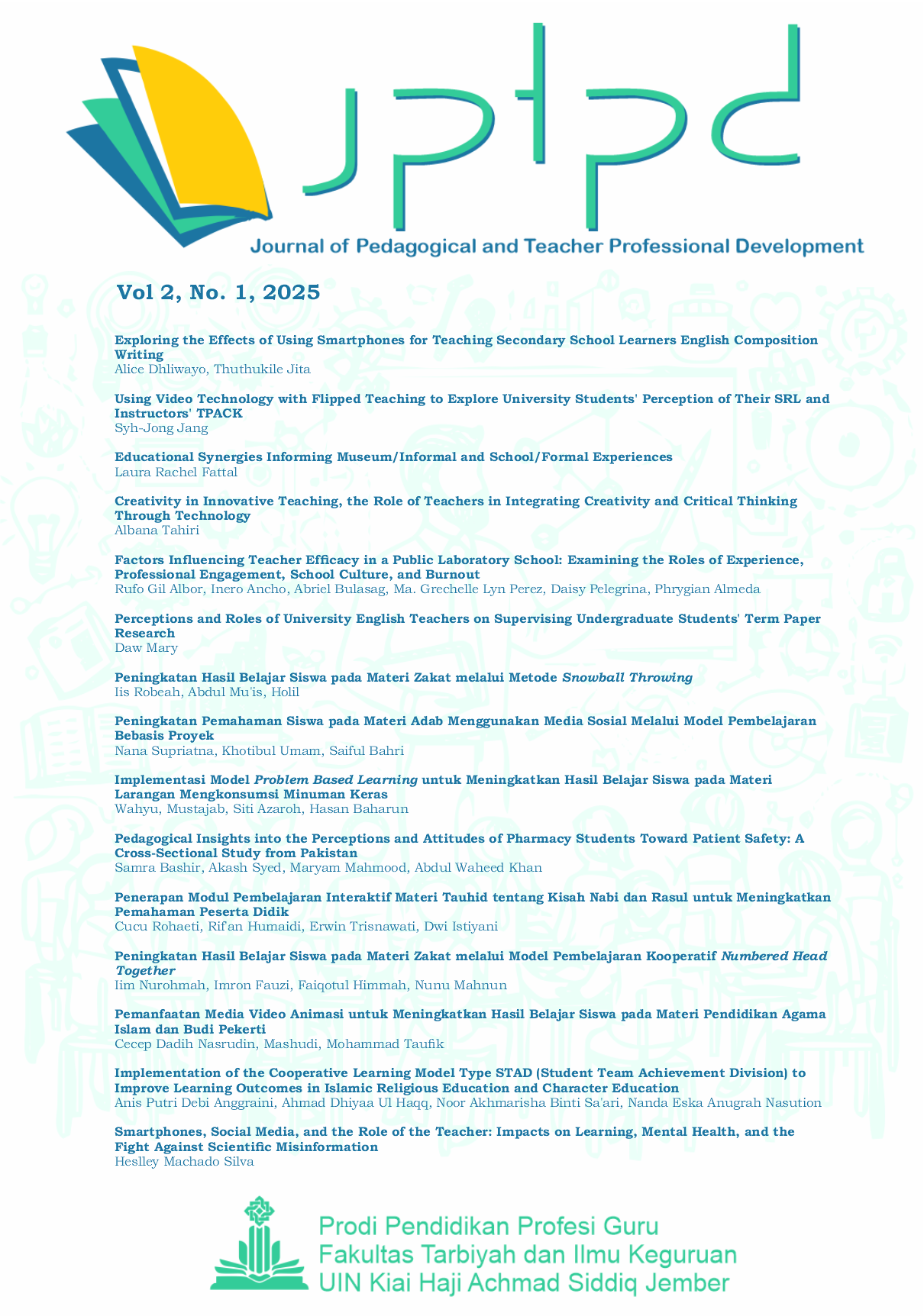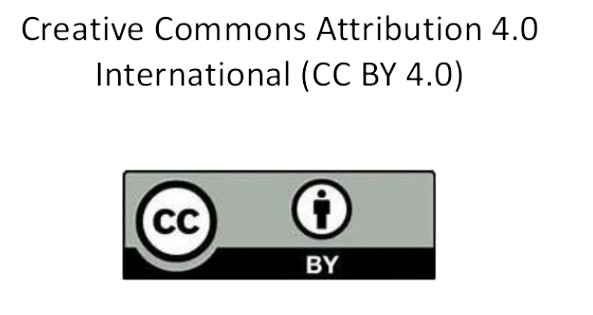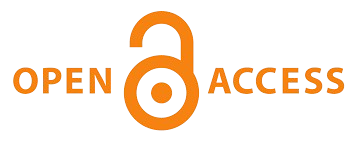Creativity in Innovative Teaching, the Role of Teachers in Integrating Creativity and Critical Thinking Through Technology
DOI:
https://doi.org/10.35719/jptpd.v2i1.958Keywords:
Creativity in Teaching, Critical Thinking, Constructivism, Educational Innovation, Sustainable Development, SDG4, Technology in EducationAbstract
Innovative teaching and creativity play a fundamental role in fostering critical thinking and creative skills among students. In alignment with the Sustainable Development Goals, education must implement strategies that encourage exploration, collaboration, and active student engagement. The integration of technology in the teaching process presents a valuable opportunity to enhance instructional effectiveness; however, a significant challenge remains the lack of technological competencies among teachers, particularly in rural areas. This study is grounded in constructivist theory and employs a mixed-methods approach, combining qualitative and quantitative research. To collect relevant data, interviews and focus groups were conducted with teachers and students, while surveys were administered to 784 students and 70 teachers from urban and rural schools in Tirana. To ensure the reliability and validity of the research instruments, the questionnaires were piloted with 50 pre-service teaching students. The results indicate that creative teaching methods and technology integration positively impact student engagement and the development of critical thinking skills. However, a considerable number of teachers face challenges in incorporating technology into their teaching practices. Therefore, it is recommended that continuous professional development programs be implemented for teachers and that digital platforms be effectively integrated into the education system to enhance teaching and learning quality.
References
Bruner, J. (1996). The culture of education. Harvard University Press. https://www.jstor.org/stable/j.ctv136c601
Chen, L., Chen, P., & Lin, Z. (2020). Artificial intelligence in education: A review. IEEE Access, 8, 75264–75278. https://doi.org/10.1109/ACCESS.2020.2988510
Facione, P. A. (1990). Critical thinking: A statement of expert consensus for purposes of educational assessment and instruction (The Delphi Report). ERIC Clearinghouse.
Facione, P. A. (2011). Critical thinking: What it is and why it counts. Insight Assessment. https://courseware.e-education.psu.edu/downloads/geog882/Critical%20Thinking%20What%20it%20is%20and%20why%20it%20counts.pdf
García-Martínez, I., Fernández-Batanero, J. M., Fernández-Cerero, J., & León, S. P. (2023). Analysing the impact of artificial intelligence and computational sciences on student performance: Systematic review and meta-analysis. Journal of New Approaches in Educational Research, 12(1), 171–197. https://doi.org/10.7821/naer.2023.1.1240
Goleman, D. (1995). Emotional intelligence: Why it can matter more than IQ. Bantam Books.
Hargreaves, A., & Fullan, M. (2012). Professional capital: Transforming teaching in every school. Teachers College Press.
Jonassen, D. (2011). Supporting problem solving in PBL. Interdisciplinary Journal of Problem-Based Learning, 5(2), 95–119. https://doi.org/10.7771/1541-5015.1256
Mayer, R. E. (Ed.). (2005). The Cambridge handbook of multimedia learning. Cambridge University Press. https://doi.org/10.1017/CBO9780511816819
Ministry of Education, Albania. (2014). Curriculum framework for pre-university education in the Republic of Albania. https://www.ascap.edu.al/wp-content/uploads/2020/02/Korniza-Kurrikulare-31.07.2014.pdf
Ministry of Education, Albania. (2021). National education strategy 2021–2026. https://arsimi.gov.al/wp-content/uploads/2021/05/Draft-Strategjia-per-Arsimin-2021-2026.pdf
Parliament of Albania. (2012). Law No. 69/2012 "On the pre-university education system". https://arsimi.gov.al/ligj-nr-69-2012-per-sistemin-arsimor-parauniversitar-ne-republiken-e-shqiperise-i-azhornuar/
Paul, R., & Elder, L. (2002). Critical thinking: Teaching students how to study and learn (part I). Journal of Developmental Education, 26(1), 36. https://www.proquest.com/openview/38edd55b50f14b51cb45fb8ac6406782/1?cbl=47765&pq-origsite=gscholar
Piaget, J. (1952). The origins of intelligence in children. International Universities Press.
Prensky, M. (2001). Digital game-based learning. McGraw-Hill.
Runco, M. A., & Jaeger, G. J. (2012). The standard definition of creativity. Creativity Research Journal, 24(1), 92–96. https://doi.org/10.1080/10400419.2012.650092
Selwyn, N. (2016). Is technology good for education? Polity Press.
Šebek, N. (2013). Teaching and learning: A reference guide for outcome-oriented teachers. Center for Democracy and Reconciliation in Southeast Europe (CDRSEE). https://csl.edu.al/wp-content/uploads/2021/12/mesimdhenia-e-te-mesuarit.pdf
Tahiri, A. (2021). Implementing innovations in student-centered teaching. In A. Csiszárik-Kocsir & P. Rosenberger (Eds.), Current studies in social sciences 2021 (pp. 135–150). ISRES Publishing. https://www.isres.org/implementing-innovations-in-student-centered-teaching-319-s.html
Tahiri, A. (2021). Technology in teaching as an empowerment of innovative education. International Journal of Social Sciences and Education Research, 7(1), 1–10. https://dergipark.org.tr/en/download/article-file/2140653
Tahiri, A., & Hadaj, G. (2022). The role of the native language curriculum and school in the language development of children. In Proceedings of the IMCIC 2022 Conference. https://doi.org/10.54808/IMCIC2022.01.181
UNESCO. (2019). Artificial intelligence in education: Challenges and opportunities for sustainable development.
UNICEF. (2016). Study report: Addressing the challenges of inclusive education in Albania. https://www.unicef.org/albania/media/476/file/Raport_studimor-Perballimi_i_sfidave_te_arsimit_gjithperfshires.pdf
UNICEF. (2018). Teacher’s handbook: Activities to support all students in school and in the classroom. https://www.unicef.org/northmacedonia/media/4306/file/MK_ManualForLearners_Report_AL.pdf
United Nations. (n.d.). Working towards the global sustainable development goals (SDG 2030). https://sdgs.un.org/goals
Vygotsky, L. S. (1978). Mind in society: The development of higher psychological processes. Harvard University Press.
Downloads
Published
How to Cite
Issue
Section
License
Copyright (c) 2025 Journal of Pedagogical and Teacher Professional Development

This work is licensed under a Creative Commons Attribution 4.0 International License.











